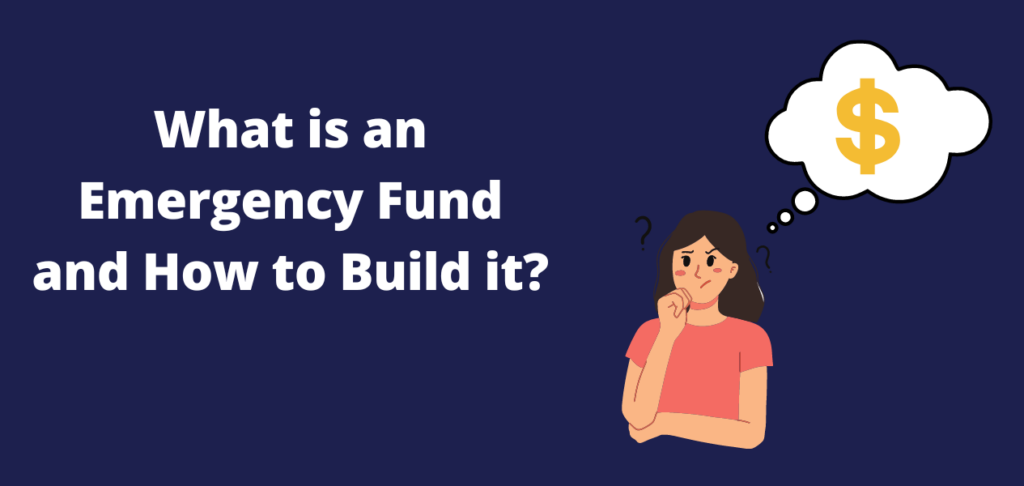Emergency often invites ambiguity and anxiety. As we’re reeling from the effects of the Covid 19 pandemic, a financial emergency is a common denominator most of us can relate to.
Sickness, lost jobs, totaled cars, and even a broken phone can sometimes derail your financial planning unless you have an emergency fund.
When you have a fund set up, emergencies don’t lead to anxiety; hence, we’re here to learn all about emergency funds today.
Topics discussed:
1. What is an Emergency Fund?
2. Why do you need an Emergency Fund?
3. How much Emergency Fund do you need approximately?
4. How to save for a successful Emergency Fund?
5. How to Build an Emergency Fund?
What is an Emergency Fund?
An emergency fund (a contingency or a rainy day fund) is reserve cash set aside expressly for emergencies. You may use this fund for unforeseen expenses like medical bills, job loss, accidents, home/appliance repairs, automobile problems, etc.
When an unplanned expense occurs out of your monthly budget, you may utilize this emergency fund without dipping into your other savings like FD or RD. Therefore, the imperative is to replenish it as soon as possible to restore the status quo of the said emergency fund.
It goes without saying that you cannot expend this fund for non-emergencies, or it would defeat the entire purpose.
Source: An essential guide to building an emergency fund | Consumer Financial Protection Bureau
Why do you need an Emergency Fund?
The pandemic, war, inflation, global warming, worsening worldwide AQI, and numerous other reasons affirm ‘why you need an emergency fund.’
As volatility increases worldwide, it pays to be prepared with an emergency fund, as the lack thereof may land you in debt.
Often, individuals without an emergency fund rely on credit cards, bank loans, and others which incur massive interests, making it hard to pay off and save.
A study shows that 29.2% of Americans spent all their emergency funds during the pandemic, while 29.6% say they spent most of it. Emergency funds were not just savings but a saving grace for nearly 60% of Americans during troubling times, which speaks volumes.
How much Emergency Fund do you need approximately?
Calculating the emergency fund you need to save each month is relatively simple, but there is more to consider.
Consideration 1: Based on the most common unexpected expenses you’ve had in the past, the number of comorbid individuals dependent on you, and other factors, you may estimate a required emergency fund. Although health insurances cover most medical expenses, you must consider smaller expenditures when calculating emergency funds.
Consideration 2: If you’re the sole earning member of your family, you must consider saving more, and if your wife, parents, or others add to the income stream of your household, you can split the emergency fund savings.
Consideration 3: Another factor to remember is the volatility of your industry and if you don’t receive a fixed income each month. In such instances, saving more than the amount calculated below is safer.
Now that you have the primary considerations sorted let’s calculate how much money an ideal emergency fund must hold.
Start by calculating your monthly income and then calculate your fixed monthly expenses. For instance, if your monthly income is Rs. 50,000 and your monthly expense is Rs. 30,000, consider the latter to calculate your emergency fund.
Ideally, experts recommend that an emergency fund hold between three to six months of your monthly expense at any given time, so you must save between Rs. 90,000 to Rs. 1,80,000.
How to save for an Emergency Fund?
You’re off to a good start if you habitually jot down your monthly expenses and make a budget. If not, follow these simple steps to save for your emergency fund.
- Make a list of your monthly household expenses in detail.
- Categorize these into obligatory and optional expenses.
- Follow the first two steps for a few months until you can calculate the average obligatory expense.
- In the process, cut down on inessential expenses, and redirect them to your emergency fund.
- If you’re a young nuclear family, consider following the same savings method as medical expenses frequently come up in houses with children.
- Prioritize emergency fund savings above mutual funds, stocks, SIP, etc.
Now that you know the fundamentals of saving for an emergency fund let’s learn how to build one.
Source: An essential guide to building an emergency fund | Consumer Financial Protection Bureau and How To Build An Emergency Fund?
How to Build an Emergency Fund?
You may find it daunting to save for an emergency fund on top of your existing savings, income tax returns, etc. But as the name entails, this is for the unexpected emergencies that unavoidably occur, so it pays to build an emergency fund.
Set a goal to establish your fund
Once you’ve decided to save for an emergency fund, it is crucial to establish a deadline. Based on your income, it may be an arduous task to imagine a goal initially, but shelving the plan is not an option. Your goal to set up an emergency fund may range from a few months to a couple of years, but it is imperative to set it regardless.
Relocate existing funds
You may currently have funds sitting dormant in FDs, RDs, cryptocurrency, gold, and other streams that you may redirect towards the emergency fund. You will reach your goal much quicker by relocating these funds towards your emergency fund.
Commit monthly
Once you set a deadline to establish your emergency fund and start to relocate reserves, committing to set aside monthly savings becomes easy. However, if the only way to save for your emergency fund is from your monthly income, committing to saving a fixed amount is a great idea.
Remember not to take a loan, borrow money, or get into any kind of debt to set up your emergency fund, but do it as a commitment for yourself and your family.
Create a dedicated emergency funds account
Creating a dedicated bank account or neo bank account for your emergency funds is crucial and necessary. The urge to spend money lying in your salary or savings account is a problem we all share, and creating a separate bank account will resolve this issue.
1. Create a joint account with your wife or parents and save your emergency funds.
2. Easily create a neo banking account that offers presets for various savings types.
3. Schedule auto-transfer of funds from your salary account.
4. Promise yourself not to withdraw from the emergency fund unless it’s an emergency.
5. Utilize liquid savings options provided by various vendors where interests can accumulate on your emergency funds.
6. Savings account of the dedicated bank account, short-term FD, and liquid mutual funds are some safe options to park your emergency fund.
Source: How To Build An Emergency Fund?
Take away
Revisit your emergency fund once a year upon reevaluating your lifestyle changes, promotions, salary hikes, etc. Increase the baseline amount of your emergency fund as required, as this sum must grow gradually alongside your career and family.
It is crucial to prioritize your emergency fund just like your insurance, as they’re both lifelines that protect you from the uncertainties of life.

